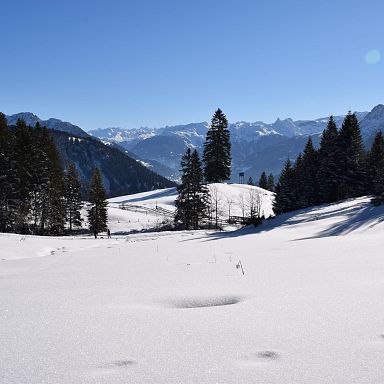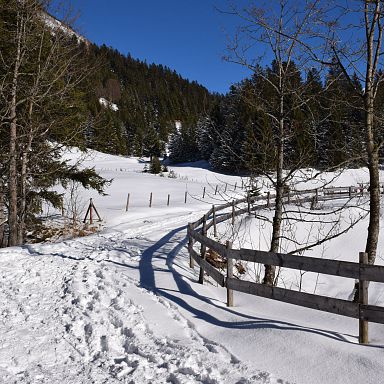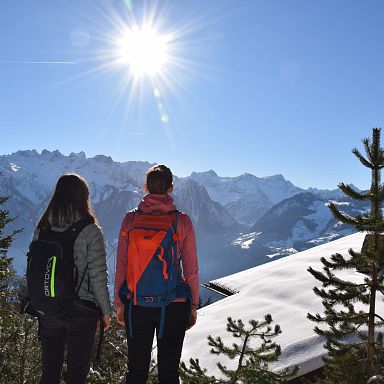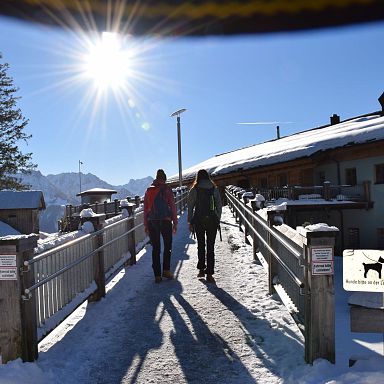The Muttersberg
The stony Ridge Walk on the favorite Mountain of the Locals
The Muttersberg - the sunny balcony at 1401 m - is a popular destination for young and old. The cable car takes you to the top station in a few minutes and you can enjoy the breathtaking mountain scenery and the varied tour options.
But why is this mountain called "Muttersberg"? How did the idea of the cable car come about? Read the whole story here including an interview with Johann Bandl, the current managing director of the cable car as well as the restaurant.
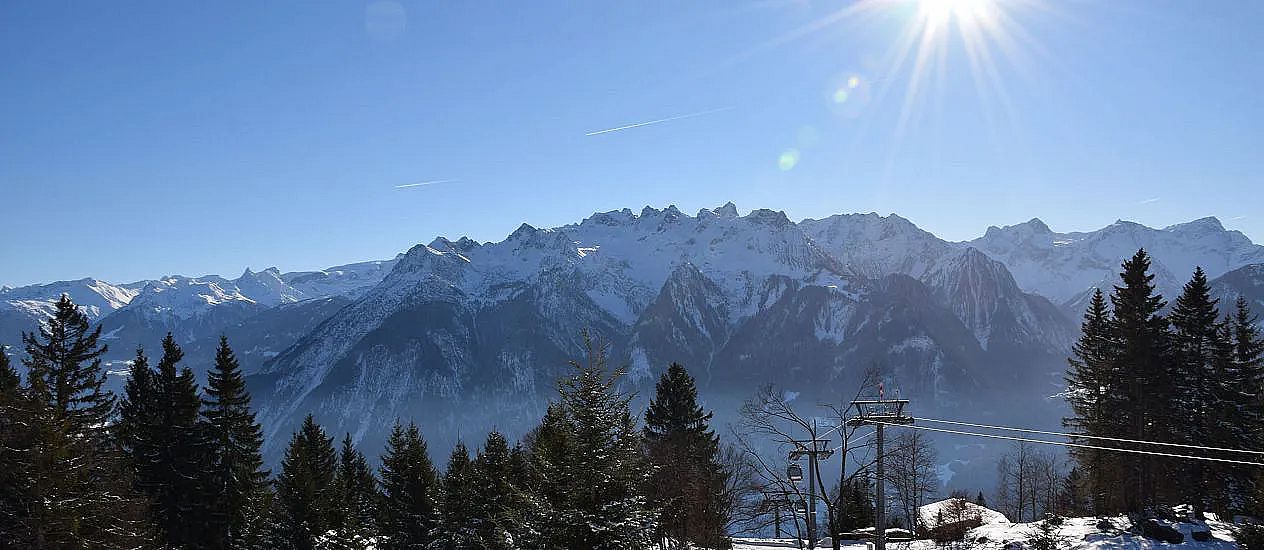
How the Muttersberg got its Name
As early as around the birth of Christ, when the Romans settled in Vorarlberg, the forests on the Madeisakopf (colloquially known as the Muttersberg) were cleared and used as cattle pastures. However, the Muttersberg was settled permanently only later by the Walsers, who came to Vorarlberg in the 14th century. The people initially settled in Laterns and reached Damüls via the Furkajoch. Over the Faschina Pass they came to Großes Walsertal, from which they finally reached the Muttersberg via the Tiefenseesattel. Due to the high altitude, the Walser farmers of that time had to work without planting cereals and thus lived mainly on potatoes, milk, cheese and meat.
Haymaking at these high altitudes required a lot of labor, which is why families usually had a lot of children. After the grass was cut and dried, it was tied into so-called "burden", which the farmers transported to the stables on their heads and backs. This kind of haymaking is traditional for the remote mountain farms in Vorarlberg. Considering that a burde weighed about 50 kilograms and about 20 of them were carried per person per day, one can imagine how cumbersome the hay work was on the Muttersberg.
But life was especially difficult due to the enormous altitude and the remoteness, because in winter or after bad weather the one-hour walk to the valley was often impassable. The difficult living conditions were one reason why the farms on the Muttersberg changed their owners frequently. The first farms belonged to two members of the Walser family "Muther". In the first half of the 16th century, there is evidence of at least four farms owned by Walsers with the name "Muther". Presumably this is how the settlement on the Madeisakopf got its present name "Muttersberg".

Development of Tourism on Muttersberg
From about 1900, most of the permanently settled farms on the Muttersberg were abandoned one after the other, the last man from Muttersberg moved to the valley in 1969. However, Muttersberg was still popular as a local recreation and vacation area, and more and more infrastructures were created for this purpose in the course of time. At times there was also a drag lift to the summit of the "Hoher Fraßen", but this was closed again in the 70s. Today you can reach the "Fraßenhütte" in about an hour's walk from the mountain station of the Muttersbergbahn. The origins of the hut go back to the birth of Christ. Already at that time there was evidence of a shelter for shepherds and cows there. In 1880, the hut came into the possession of wealthy factory brothers who were founding members of the Vorarlberg Alpine Club and thus interested in promoting mountain tourism. They generously rebuilt the hut and operated a gastronomy business and accommodation station. After the death of the brothers, the hut came into the possession of the Alpine Club section Bludenz in 1927. In the 1980s the hut was completely rebuilt. Today, the "Fraßenhütte" is still a popular destination for hikers on the Muttersberg.
Another popular hiking destination from the Muttersberg mountain station is the Alp Els. The name of this one goes back to the rhaeto-romanic language - it is therefore also a very old alpine pasture. In 1940 the alpine pasture was generously rebuilt, today it is open for guests - fresh alpine products can be tasted.
For a time there was also a hotel on the Muttersberg, which was closed again in 1981 due to a lack of tourists and converted into an apartment house. Originally, this was built in 1926 as a vacation home for train transport personnel, as the son of the landowner was the president of the ÖBB (Austrian National Railway) locomotive drivers.
After the Second World War, the intention was to boost the tourist economy in Vorarlberg and make it easier for tourists as well as locals to access the Muttersberg - the idea for the construction of a passenger cable car was born.
Muttersberg Cable Car
The cable car was built in 1955 and opened in 1956 as part of a large public festival. It was considered a masterpiece of alpine ropeway construction and was equipped with the most modern technology of the time. Shortly after, the "Madeisa-Stüble" was built, a snack station for the cable car passengers, right next to the mountain station. In the beginning, extremely good frequencies were predicted for the cable car, but these could not be reached by far, since the trend at that time was towards bathing and beach vacations. In 1970, it was considered to shut down the cable car, but the community of Nüziders and the city of Bludenz contributed a lot of financial means to keep the cable car running. Thank god!
In 1992 there was a first renewal of the cable car, it was equipped with the latest electronics and new panorama gondolas. But already in 1999 it was discovered that the suspension cables also needed to be renewed. The losses had increased over the years and therefore the city of Bludenz and the municipality of Nüziders were forced to make a decision. Finally, the Muttersberg Cable Car was sold to Nova Cable Car Company in 2001, subject to certain conditions. The company had to completely renew the cable car as well as build a large panoramic mountain restaurant (Alpengasthof Muttersberg). The "Silvretta-Nova Bergbahnen-Gesellschaft" finally took over the operating guarantee. However, about ten years later they decided to pull out of the Muttersberg. The story of the "economic problem child" continued....
It was finally possible to find buyers for the cable car. The love of the locals for the Muttersberg became clear again here, because the cable car came into private ownership of four citizens from Bludenz and Nüziders. One of them is the current partner and operational manager Johann Bandl, who knows interesting things about "his" Muttersberg...
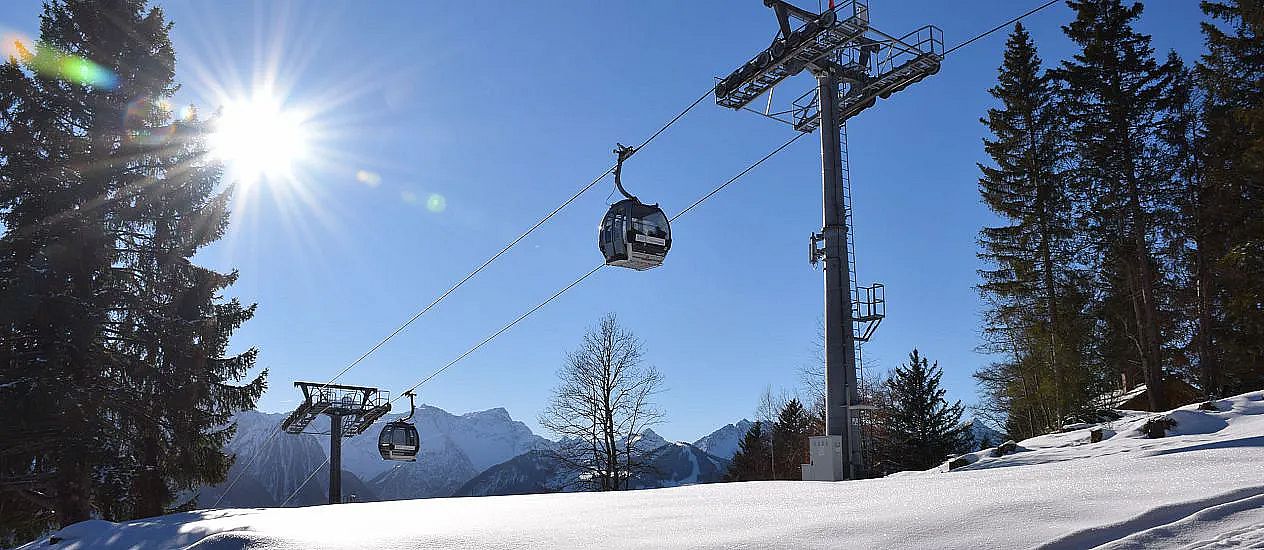
Talking with Johann Bandl
Shortly before Johann Bandl has to start preparing the lunch business at Alpengasthof Muttersberg, I catch him for a quick interview and learn interesting details about the management at Muttersberg.
Johann "Hansi" Bandl has been a partner and operational manager of "Muttersberg Seilbahn und Gastronomie GmbH" since 01/07/2012. Curious, I ask what work is regularly involved in operating such a cable car. "Safety always comes before profitability!", Hansi emphasizes in the conversation. But what safety-relevant procedures are there at the cable car? In addition to the annual inspection, the employees inspect the gondolas, the brakes and the optimal functioning of the ropes on a daily basis. During the rope inspection, the cable car is driven very slowly and several people check whether everything is running smoothly. The employees of the cable car as well as the restaurant staff have to take part in fire-air, day rescue, "Red Cross" as well as mountain rescue exercises every year. For example, they practice abseiling from the gondolas in an emergency. A breezy adventure! Through the annual refresher course, all employees are trained to act quickly and correctly if an emergency situation arises. The cabins are hung from the garage into the ropes every day as well as "cleaned up" again in the evening. "At the cable car, I have an operations manager who takes 90% of the work. I'm fully involved in the gastronomy business," says Hansi.
But even he is not spared the economic worries that already plagued his predecessors. "Already in 2013, they wanted to stop the cable car again - only no one knows.", Hansi smiles, "The rides have already been increased, it's going in the right direction, but it's always a tightrope walk on the Muttersberg.". Despite the difficulties, the preservation of the cable car and the alpine inn seems to be an important concern among the population. The operators also see themselves as responsible to the region, because the Muttersberg is an important recreation area, especially for the locals. "We have 80% local guests at the Muttersberg. The cable car will be 66 years old in October - since always the Muttersberg has been a popular destination for the local population," explains Hansi, "Our main season actually runs from August to September. Currently we are in weekend operation, because it would not be economically worthwhile during the week. I would like to offer people the opportunity to come to the Muttersberg at least on weekends, especially for my regular guests and the people who want to come again and again to the Muttersberg. When we're closed, we already notice that people keep calling."
The Muttersberg has remained an economic problem, but the love for the Muttersberg among the population is so great that the cable car has now been supported for almost 66 years - and hopefully this will continue, so that many more happy eyes can enjoy the breathtaking view from the Muttersberg into the surrounding mountain scenery.
This could be of interest for you:
Impressions
Sources:
www.muttersberg.at; Zech, O., Concin, J., & Bußjäger, P. (2003). Muttersberg Laz: die Bergparzellen von Nüziders und der Bergbau bei Bludenz. Geschichtsverein Region Bludenz. Interview mit Johann Bandl


